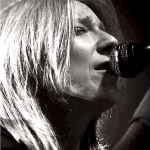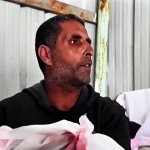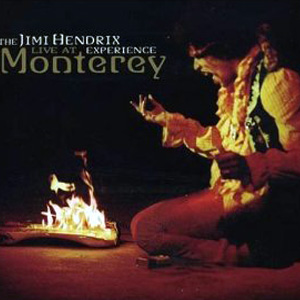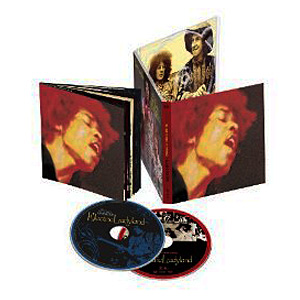Jimi Hendrix Life, Times & Fire
USA At Last!
Although very popular internationally at this time, the Experience had yet to crack America, and their first single there failed to sell. Their chance came when Paul McCartney recommended the group to the organizers of the Monterey International Pop Festival. This proved to be a great opportunity for Hendrix, not only because of the large audience present at the event, but also because of the many journalists covering the event that wrote about him. The performances were filmed by D. A. Pennebaker and later shown in some movie theatres around the country in early 1969 as the concert documentary Monterey Pop, which immortalized Hendrix’s iconic burning and smashing of his guitar at the finale of his performance.
The opening song was Hendrix’s very fast arrangement of Howlin’ Wolf’s 1965 R&B hit “Killing Floor.” He played this frequently from late 1965 through 1968, usually as the opener to his shows. The Monterey performance included an equally lively rendition of B.B. King’s 1964 R&B hit “Rock Me Baby”, Tim Rose’s arrangement of “Hey Joe” and Bob Dylan’s 1965 pop hit “Like A Rolling Stone.” The set ended with The Troggs “Wild Thing” and Hendrix repeating the act that had boosted his profile in the UK (and internationally) with him burning his guitar on stage, then smashing it to bits and tossing pieces out to the audience. This show finally brought Hendrix to the notice of the US public. A large chunk of this guitar was on display at the Experience Music Project in Seattle, along with the other psychedelically painted Stratocaster that Hendrix smashed (but did not burn) at his farewell concert in England before he left for the US and Monterey.
At the time Hendrix was playing sets in the Scene club in NYC in July 1967, he met Frank Zappa, whose Mothers of Invention were playing the adjacent Garrick Theatre, and he was reportedly fascinated by Zappa’s recently-purchased wah-wah pedal. Hendrix immediately bought one from Manny’s and starting using it right away on the sessions for both sides of his new single, and slightly later, on several jams recorded at Ed Chalpin’s studio.
Following the festival, the Experience played a series of concerts at Bill Graham’s Fillmore replacing the original headliners Jefferson Airplane at the top of the bill. It was at this time that Hendrix became acquainted with future musical collaborator Stephen Stills, and reacquainted himself with Buddy Miles who introduced Hendrix to his future partner, Devon Wilson. She had a turbulent on/off relationship with him, right up to the night of his death, and was the only one of his partners to record with him. She died only six months after Hendrix, apparently falling from an upper window in the Chelsea Hotel.
Following this very successful West Coast introduction, which also included two open air concerts (one of them a free concert in the “panhandle” of Golden Gate Park) and a concert at the Whisky a Go Go, they were booked as one of the opening acts for pop group The Monkees on their first American tour. The Monkees asked for Hendrix because they were fans, but their mostly early teens audience sometimes did not warm to their act, and he quit the tour after a few dates. Chas Chandler later admitted that being thrown off the Monkees tour was engineered to gain maximum media impact and publicity for Hendrix, similar to that gained from the manufactured Rank Theatre’s ‘indecency dispute’ on the earlier UK Walker Brothers tour.
Meanwhile, in Western Europe, where Hendrix was also appreciated for his authentic blues renditions as well as his hit singles, and was often recognised for his avant-garde musical ideas, his wild-man image and musical gimmickry (such as playing the guitar with his teeth and behind his back) had faded; but they later plagued him in the US following Monterey. He became frustrated by the US media and audience when they concentrated on his stage tricks and best known songs.

AXIS: BOLD AS LOVE
The Jimi Hendrix Experience’s second 1967 album, AXIS: BOLD AS LOVE was his first recording made with a view to a stereo release and was where he first experimented with this format, using much panning and other stereo effects. It continued the style established by Are You Experienced. The opening track, “EXP”, featured a stereo effect in which a sound emanating from Hendrix’s guitar appeared to revolve around the listener, fading out into the distance from the right channel, then returning in on the left. This album marked the first time Hendrix recorded the whole album with his guitar tuned down one half-step, to E, which he used exclusively thereafter and was his first to feature the wah-wah pedal. A mishap almost delayed the album’s pre-Christmas release: Hendrix lost the master tape of side one of the LP, leaving it in the back seat of a London taxi. With the release deadline looming, Hendrix, Chas Chandler and engineer Eddie Kramer had to remix most of side one in an overnight session, but they couldn’t match the lost mix of “If 6 Was 9.” They soon learned that bassist Noel Redding had a tape recording of this mix. The tape had to be smoothed out as it had gotten wrinkled. Hendrix was disappointed that the album had to be finished so quickly and felt it could have been better, given more time. He was also somewhat disappointed in the album cover art work, which depicts Hendrix and his Experience band-mates as the various forms of Vishnu, incorporating a painting of them by Roger Law (from a photo-portrait by Karl Ferris). Hendrix remarked that it would have been more appropriate if the cover had highlighted his American Indian heritage.
The album was released in the UK near the end of their first headlining tour there, after which the pace slowed briefly during the Christmas holidays. In January 1968 the group went to Sweden for a short tour, and after the first show Hendrix, reportedly after drinking, went berserk and smashed up his hotel room in a rage, injuring his hand and culminating in his arrest. Then on the 6th in Denmark his famous hat was stolen. The rest of the tour was uneventful, though Hendrix had to spend some time in Sweden waiting for his trial and eventual large fine.
ELECTRIC LADYLAND
Hendrix’s third recording, the double-album ELECTRIC LADYLAND (1968), was a departure from previous recordings. Following his third and penultimate French concert at the Paris Olympia, Hendrix flew to the US to start his first tour there, and after two months returned to his Electric Ladyland project at the newly opened Record Plant Studios with engineers Eddie Kramer, Gary Kellgren, with Chas Chandler initially as producer.
As the album’s recording progressed, Chas Chandler became so frustrated with Hendrix’s perfectionism and with various friends and guests milling about the studio that he decided to sever his professional relationship with Hendrix. Chandler’s departure had a clear impact on the artistic direction that the recording took.
Hendrix began experimenting with different combinations of musicians and instruments, and modern electronic effects. For example, Dave Mason, Chris Wood, and Steve Winwood from the band Traffic, drummer Buddy Miles and former Bob Dylan organist Al Kooper, among others, were involved in the recording sessions. He described how Hendrix went from a disciplined recording regime to an erratic schedule, which often saw him beginning recording sessions in the middle of the night, and with any number of guests.
Chandler also expressed exasperation at the number of times Hendrix would insist on re-recording particular tracks; the song “Gypsy Eyes” was reportedly recorded 43 times. This was also frustrating for bassist Noel Redding, who would often leave the studio to calm himself, only to return and find that Hendrix had recorded the bass parts himself during Redding’s absence. The effects of these events can clearly be identified in the album’s musical style. They often lacked easily identifiable patterns or sections, and would sometimes lack even a recognisable melody. More particularly, however, the themes that the songs addressed, and the music that Hendrix recorded, went far beyond anything he had previously achieved.
Electric Ladyland includes a number of compositions and arrangements for which Hendrix is still remembered. These include “Voodoo Child (Slight Return)” as well as Hendrix’s rendition of Bob Dylan’s “All Along the Watchtower.”
Throughout the four years of his fame, Hendrix often appeared at impromptu jams with various musicians, such as B.B. King. In March 1968, Jim Morrison of The Doors joined Hendrix onstage at New York’s Scene Club.
Break-up Time
After a year based in the US, Hendrix temporarily moved back to London and into his girlfriend Kathy Etchingham’s rented Brook Street flat, next door to the Handel House Museum, in London’s West End. During this time The Jimi Hendrix Experience toured Scandinavia, Germany, and included a final French concert. They later performed two sold-out concerts at London’s Royal Albert Hall on February 18 and February 24, 1969, which were the last European appearances of this line-up of the Jimi Hendrix Experience. A Gold and Goldstein-produced film titled “Experience” was also recorded at these two shows, which, according to Experience Hendrix LLC, “Elements of these recordings are sure to be utilised when the official release of this material is finally made.”
Noel Redding felt increasingly frustrated by the fact that he was not playing his original and favoured instrument, the guitar. In 1968, he decided to form his own band, Fat Mattress, which would sometimes open for the Experience (Hendrix would jokingly refer to them as “Thin Pillow”). Redding and Hendrix would begin seeing less and less of each other, which also had an effect in the studio, with Hendrix playing many of the bass parts on Electric Ladyland.
Fruitless recording sessions at Olympic in London; Olmstead and the Record Plant in New York that ended on April 9, which only produced a remake of “Stone Free” for a possible single release, were the last to feature Redding. Jimi then flew Billy Cox up to New York and started recording and rehearsing with him on April 21 as a replacement for Noel.
In a recorded interview by Nancy Carter on June 15 at his hotel in Los Angeles, Hendrix announced that he had been recording with Cox and that he would be replacing Noel as bass player in The Jimi Hendrix Experience.
The last Experience concert took place on June 29, 1969 at Barry Fey’s Denver Pop Festival, a three-day event held at Denver’s Mile High Stadium that was marked by police firing tear gas into the audience as they played “Voodoo Child (Slight Return).” The band escaped from the venue in the back of a rental truck which was partly crushed by fans trying to escape the tear gas. The next day, Noel Redding announced that he had quit the Experience.
|
|

|

Taking Back Sunday |
LATEST GALLERY IMAGES

The Price of Food 
The Invisible Enemy |
|
|



